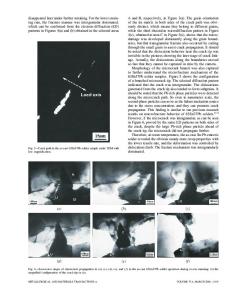In situ study on Cu-Ni cross-interaction in Cu/Sn/Ni solder joints under temperature gradient
- PDF / 704,324 Bytes
- 9 Pages / 584.957 x 782.986 pts Page_size
- 21 Downloads / 333 Views
Synchrotron radiation real-time imaging technology was performed to in situ study the Cu–Ni cross-interaction in Cu/Sn/Ni solder joints under temperature gradient during soldering. The direction of temperature gradient significantly influenced the Cu–Ni cross-interaction. When Ni was the hot end, both Cu and Ni atoms could diffuse to the opposite interfaces, resulting in the occurrence of the Cu–Ni cross-interaction at both interfaces. The consumption of the Cu cold end was abnormally large, whereas that of the Ni hot end was limited. When Cu was the hot end, only Cu atoms could diffuse to the opposite interface, resulting in the occurrence of the Cu–Ni cross-interaction only at the cold end. The Cu hot end was seriously consumed, whereas the Ni cold end was still intact. The interfacial intermetallic compounds were always thicker at the cold end than at the hot end, especially at the Ni/Sn cold end. Cu imposed more damaging effect than Ni under temperature gradient. Based on the atomic fluxes, a model was proposed to discuss the effect of temperature gradient on the Cu–Ni cross-interaction and the interfacial reactions in the Cu/Sn/Ni solder joints.
I. INTRODUCTION
As shrinking of the critical dimensions in integrated circuits becomes increasingly difficult, semiconductor industry resorts to other approaches to achieve the objective of building new devices that consume less power but have higher performance. To this end, three dimensional integrated circuit (3D IC) architecture that allows higher performance in a much smaller package has been receiving wide attentions.1–3 In 3D IC packaging, interfaces between under bump metallizations (UBMs) and solder bumps play an important role in achieving a reliable interconnection.4,5 Generally, the solder bumps need to go through several reflows during which solder/ UBM liquid–solid interfacial reactions occur.1 There may be a temperature gradient existing during the reflow process in an oven or on a hot plate due to the differences in thermal conduction and dissipation among the chips, solder bumps, and substrate. For hot compression method, heat is applied through one of the chips and a temperature gradient across the micro bumps will be generated.6–8 In addition, due to the combined effect of current crowding and joule heating, solder alloy may melt locally9,10 and huge temperature gradient exceeding 2000 °C/cm may develop across the solder bumps in service.11 As the diameter of solder bumps is downsizing, Contributing Editor: C. Robert Kao a) Address all correspondence to this author. e-mail: [email protected] DOI: 10.1557/jmr.2016.45 J. Mater. Res., Vol. 31, No. 5, Mar 14, 2016
issues caused by temperature gradient will become more serious. Thermomigration (TM) is one of the simultaneous heat and mass transfer phenomena that occurs in a mixture, as a result of an external temperature gradient imposed across the mixture. Under a certain temperature gradient, TM occurs in solder joints.8,11–15 Since the interdiffusion of atoms between solder and UBMs can markedly affect t
Data Loading...











